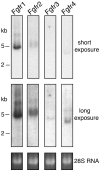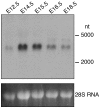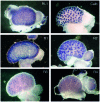Evidence that the novel receptor FGFRL1 signals indirectly via FGFR1
- PMID: 24026051
- PMCID: PMC3820611
- DOI: 10.3892/ijmm.2013.1484
Evidence that the novel receptor FGFRL1 signals indirectly via FGFR1
Abstract
Fibroblast growth factor (FGF) receptor-like protein 1 (FGFRL1) is a recently discovered member of the FGF receptor (FGFR) family. Similar to the classical FGFRs, it contains three extracellular immunoglobulin-like domains and interacts with FGF ligands. However, in contrast to the classical receptors, it does not contain any intracellular tyrosine kinase domain and consequently cannot signal by transphosphorylation. In mouse kidneys, FgfrL1 is expressed primarily at embryonic stages E14-E15 in regions where nascent nephrons develop. In this study, we used whole-mount in situ hybridization to show the spatial pattern of five different Fgfrs in the developing mouse kidney. We compared the expression pattern of FgfrL1 with that of other Fgfrs. The expression pattern of FgfrL1 closely resembled that of Fgfr1, but clearly differed from that of Fgfr2‑Fgfr4. It is therefore conceivable that FgfrL1 signals indirectly via Fgfr1. The mechanisms by which FgfrL1 affects the activity of Fgfr1 remain to be elucidated.
Figures



Similar articles
-
Targeted disruption of the intracellular domain of receptor FgfrL1 in mice.PLoS One. 2014 Aug 15;9(8):e105210. doi: 10.1371/journal.pone.0105210. eCollection 2014. PLoS One. 2014. PMID: 25126760 Free PMC article.
-
Biology of FGFRL1, the fifth fibroblast growth factor receptor.Cell Mol Life Sci. 2011 Mar;68(6):951-64. doi: 10.1007/s00018-010-0576-3. Epub 2010 Nov 16. Cell Mol Life Sci. 2011. PMID: 21080029 Free PMC article. Review.
-
Role of fibroblast growth factor receptors (FGFR) and FGFR like-1 (FGFRL1) in mesenchymal stromal cell differentiation to osteoblasts and adipocytes.Mol Cell Endocrinol. 2018 Feb 5;461:194-204. doi: 10.1016/j.mce.2017.09.015. Epub 2017 Sep 18. Mol Cell Endocrinol. 2018. PMID: 28923346
-
Fibroblast growth factor receptor like-1 (FGFRL1) interacts with SHP-1 phosphatase at insulin secretory granules and induces beta-cell ERK1/2 protein activation.J Biol Chem. 2013 Jun 14;288(24):17859-70. doi: 10.1074/jbc.M112.440677. Epub 2013 May 2. J Biol Chem. 2013. PMID: 23640895 Free PMC article.
-
Role of FGFRL1 and other FGF signaling proteins in early kidney development.Cell Mol Life Sci. 2013 Jul;70(14):2505-18. doi: 10.1007/s00018-012-1189-9. Epub 2012 Oct 31. Cell Mol Life Sci. 2013. PMID: 23112089 Free PMC article. Review.
Cited by
-
DNA methylation and gene expression patterns in adipose tissue differ significantly within young adult monozygotic BMI-discordant twin pairs.Int J Obes (Lond). 2016 Apr;40(4):654-61. doi: 10.1038/ijo.2015.221. Epub 2015 Oct 26. Int J Obes (Lond). 2016. PMID: 26499446
-
Targeted disruption of the intracellular domain of receptor FgfrL1 in mice.PLoS One. 2014 Aug 15;9(8):e105210. doi: 10.1371/journal.pone.0105210. eCollection 2014. PLoS One. 2014. PMID: 25126760 Free PMC article.
-
Targeting fibroblast growth factor receptors causes severe craniofacial malformations in zebrafish larvae.PeerJ. 2022 Nov 23;10:e14338. doi: 10.7717/peerj.14338. eCollection 2022. PeerJ. 2022. PMID: 36444384 Free PMC article.
-
FGFRL1 affects chemoresistance of small-cell lung cancer by modulating the PI3K/Akt pathway via ENO1.J Cell Mol Med. 2020 Feb;24(3):2123-2134. doi: 10.1111/jcmm.14763. Epub 2020 Jan 19. J Cell Mol Med. 2020. PMID: 31957179 Free PMC article.
-
Dissecting the Interaction of FGF8 with Receptor FGFRL1.Biomolecules. 2020 Oct 1;10(10):1399. doi: 10.3390/biom10101399. Biomolecules. 2020. PMID: 33019532 Free PMC article.
References
-
- Itoh N. The Fgf families in humans, mice, and zebrafish: their evolutional processes and roles in development, metabolism, and disease. Biol Pharm Bull. 2007;30:1819–1825. - PubMed
Publication types
MeSH terms
Substances
LinkOut - more resources
Full Text Sources
Other Literature Sources
Molecular Biology Databases
Research Materials
Miscellaneous

